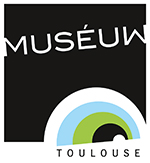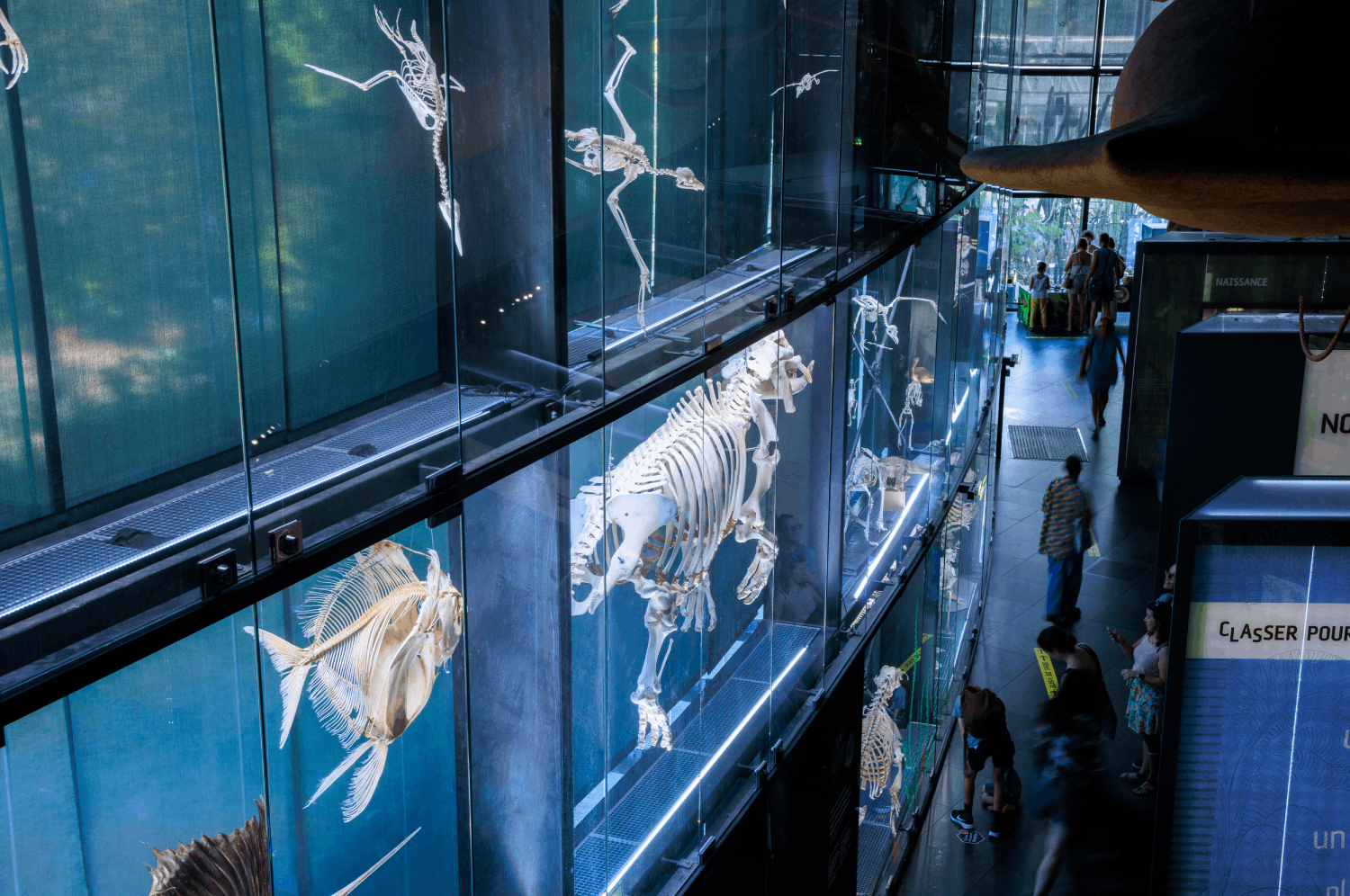
The permanent exhibition, a journey to the heart of the living world
The Museum’s permanent exhibition invites you to immerse yourself in the vast world of living things, and discover the Earth and its inhabitants. The Museum’s permanent exhibition takes you through a number of different areas…
Visit time 2h
Temporary exhibition period €12
Outside the temporary exhibition period €8
French / English
Access for disabled people
The exhibition in detail
The Museum’s permanent exhibition invites you to immerse yourself in the vast world of living things, and discover the Earth and its inhabitants.
The Museum’s permanent exhibition takes you through a number of different areas to discover the close interactions between the planet’s transformations and the adaptations of the organisms that inhabit it, and to explore the richness and depth of the relationships between humans, nature and the environment.
Fascinated by fossils? Amazed by lepidoptera (butterflies!)? Impressed by the variety of vertebrates? Want to understand the rituals that link humans to nature?
Whether you’re a connoisseur, an amateur, an experienced scientist or a budding youngster, the Museum’s permanent exhibition offers you a journey full of surprises and excitement, to improve your curiosity and stimulate your thinking.
A look at the Museum’s permanent exhibition
- 2,600 m² of exhibition space
- 4000 specimens on display
- 5 themed areas
- Map of the Museum
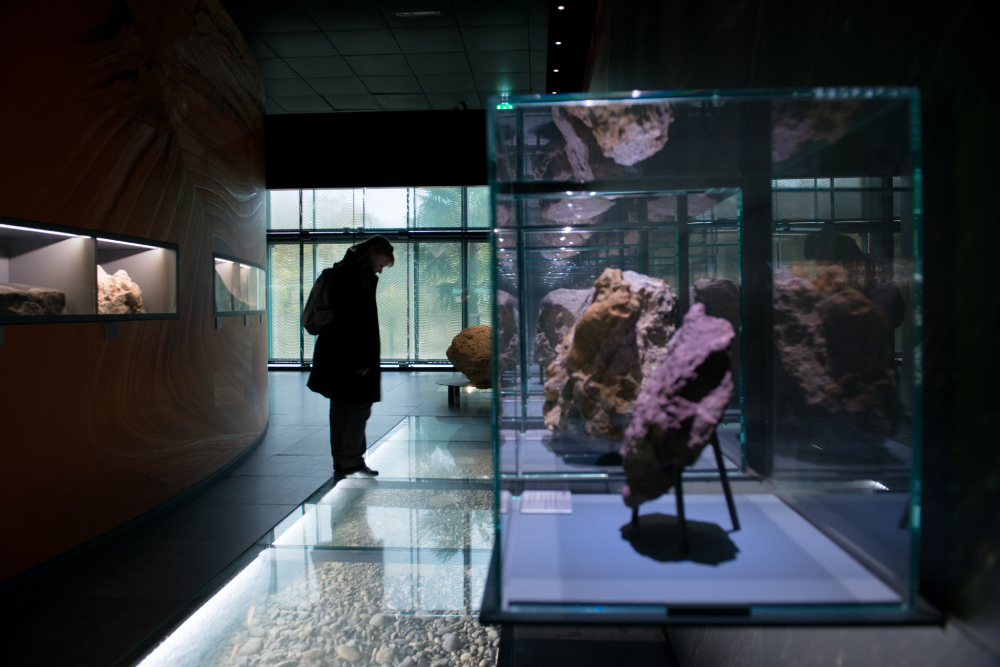
Earth, an active planet
In 3 stages, 6 rooms present the nature and movements of the planet Earth, from its creation to the appearance of life.
Wonderful alchemy
In the bowels of the Earth
Plunged into the heart of matter, we start with the chemical elements, rocks and minerals that make up the Earth. They tell us how the diversity of shapes, materials and colours that shape our planet comes about.
More than 4,500 subsoil minerals have now been catalogued. Sometimes spectacular, like this fluorescent autunite, they make up an astonishing diversity.
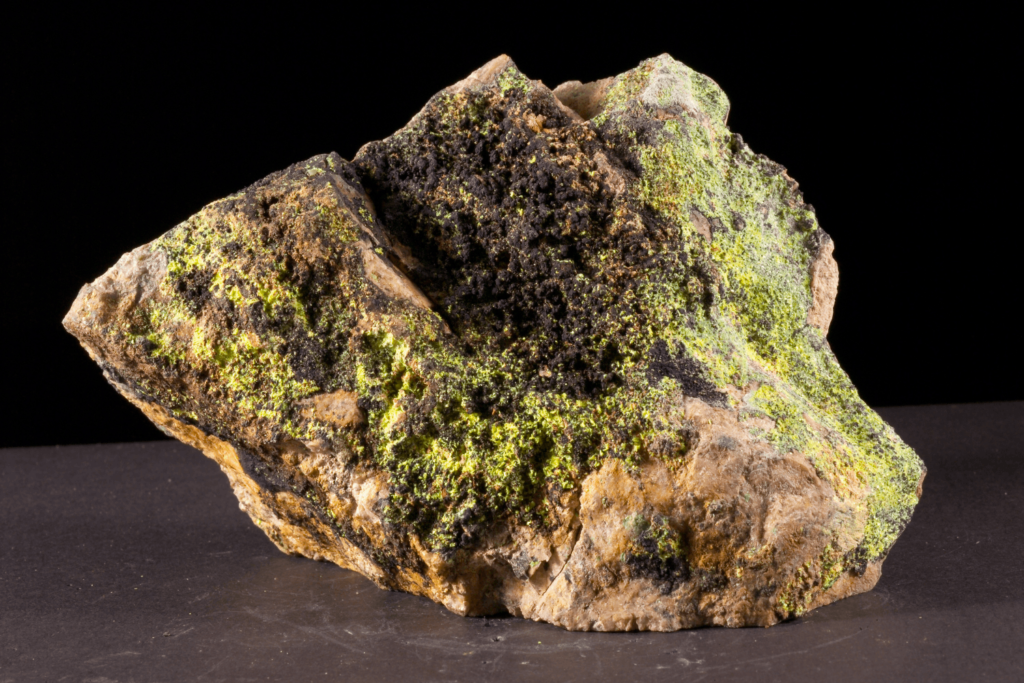
The Infinitely Big
Born from the Universe
Here we are in the gravitational vortex that created the Earth, born from a cloud of gas and stellar dust. Observe the meteorites and imagine their journey to understand the Earth’s gravitational pull and its position in the solar system.

The power of the Earth
Sculpted by the force of nature’s elements
The last four rooms of the Museum’s permanent exhibition are dedicated to the four natural elements: earth, fire, water and air. The Earth is alive. The coming together of the elements causes earthquakes, volcanic eruptions, the creation of rivers and landforms… but also the beginning of life.
Formed underwater, this giant stromatolite of bacteria and sediment bears one of the earliest traces of life on Earth.

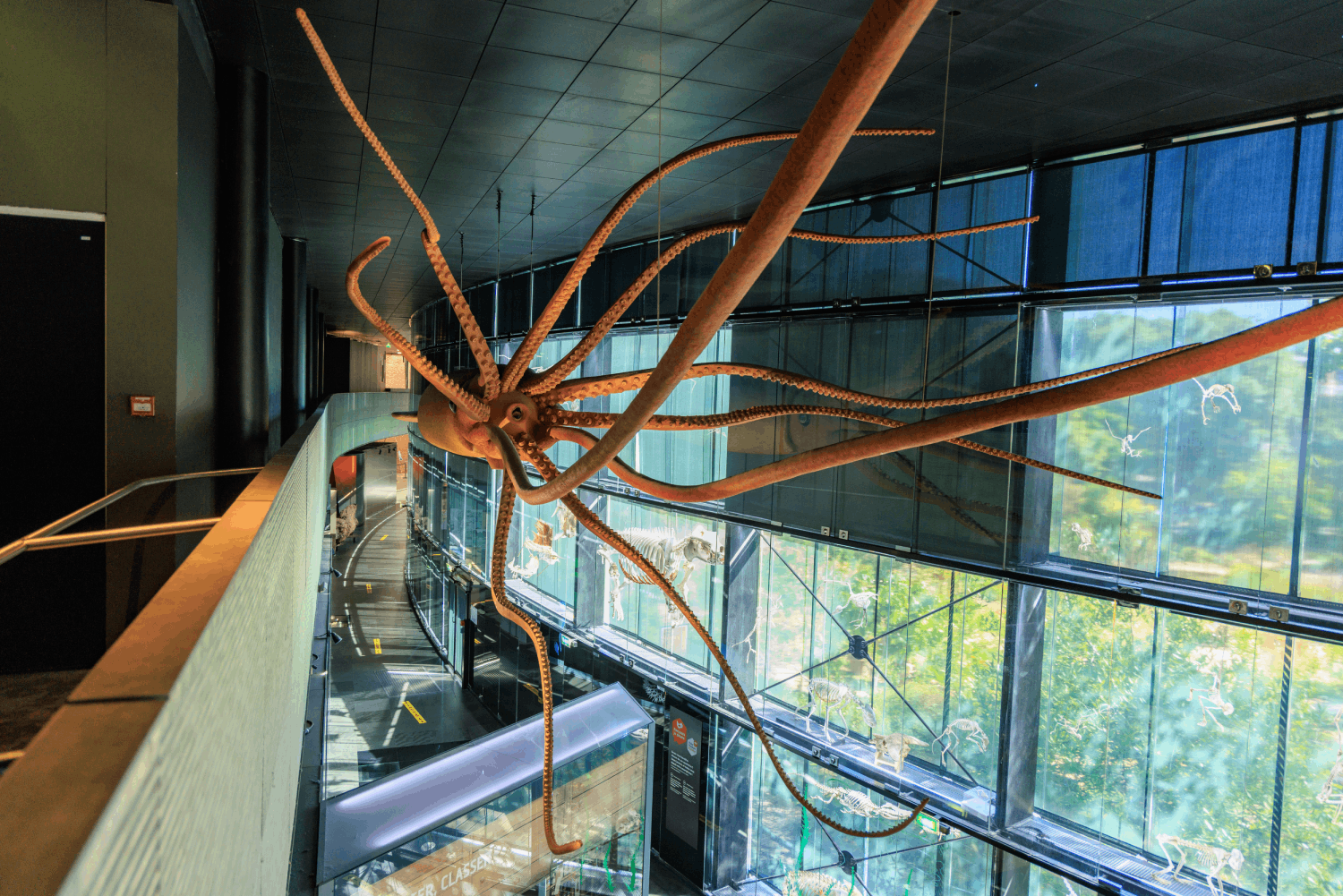
Order of living things
Follow the giant squid and learn to find your way through the hustle and bustle of life.
Classifying for knowledge
Observe and understand
To understand the world around us and its diversity, humans have classified, sorted and inventoried. In front of the showcases of the cabinet of curiosity, we become aware of the incredible variety of specimens to identify and characteristics to observe.
These owls belong to the same family (strigidae), but are in fact different species… look out for their distinctive features.
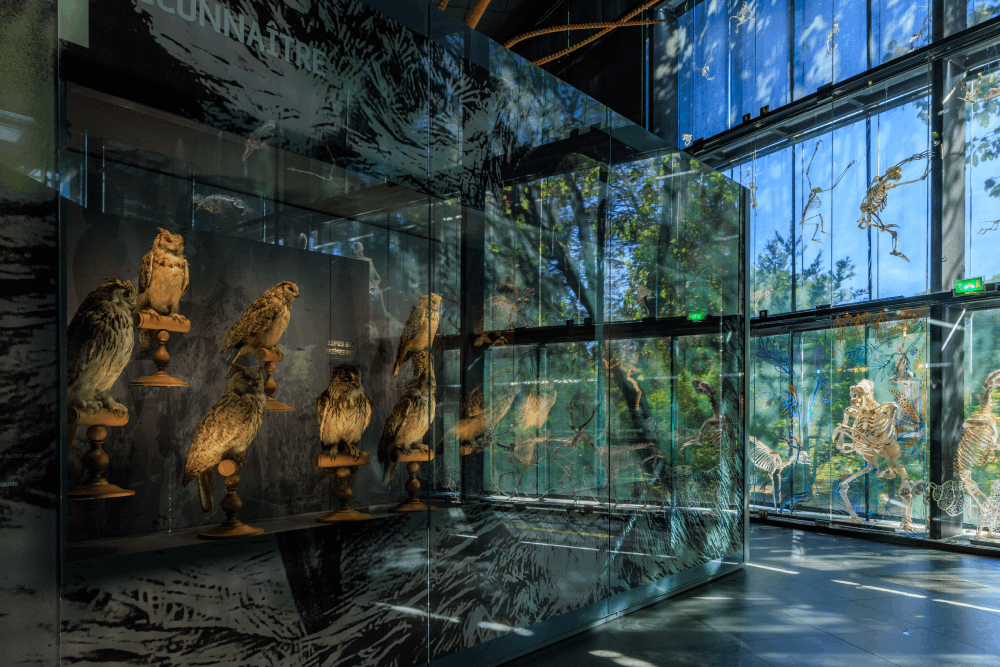
Skeleton wall
Life in motion
Under the giant whale skeleton, 75 vertebrate skeletons fly, glide, run, jump, crawl or move from branch to branch.They form an immense moving fresco showing the different ways of life adapted to their environment.
Can you find out which animal each skeleton belongs to?

Ordering living things
Tracking the evolution of life
Stop off at the phylogenetic tree to see the characteristics developed by different living things over the course of their evolution, and classify them. Then take a look at the gallery of life between the different groups: plants, insects, molluscs, mammals and birds sometimes show surprising changes!


Continuum and breaks
As the earth’s environment changes, living organisms appear, disappear and undergo metamorphosis…
This journey from the origins of life to our contemporary world presents the different adaptations of living organisms.
Past and future?

29 steps to travel through four billion years of time! Five circles of time, represented by blue rings painted on the wall, take us through these stages of time, from the formation of the Earth to the appearance of the first living organisms. An ascent to grasp the time of evolution
Paleozoic: and life appears
The ascent places us on the tree of life, 600 billion years away. This is the era of the first lives. Living organisms occupied all the environments that were favourable to their development: water, earth and air. And they develop adapted structures: shells, bones, seeds…
Fossilised amphibian footprints bear witness to the earliest forms of life.


Mesozoic: from ammonites to dinosaurs
This was an era of abundance, with mammals, birds, ammonites and, of course, dinosaurs flourishing in a favourable environment. Until the Cretaceous-Tertiary crisis, 65.5 billion years ago, which marked the disappearance of the dinosaurs and the survival of small mammals, including the first ancestors of primates.
This Baryonyx is a European dinosaur. It fed mainly on fish, which is why it is found in aquatic environments. Hence its similarity to the crocodile, with which it shares a long, flattened nose.
Cenozoic: a time of change
Continents formed and climates became more temperate. Species adapted and new forms appeared. Mammals and birds diversified enormously. Lava, mud, amber… natural traps capture evidence of these changes.
After the disappearance of the dinosaurs, the largest land animals were birds. Like this Gastornis, a giant over 2 m tall, which was a herbivore.

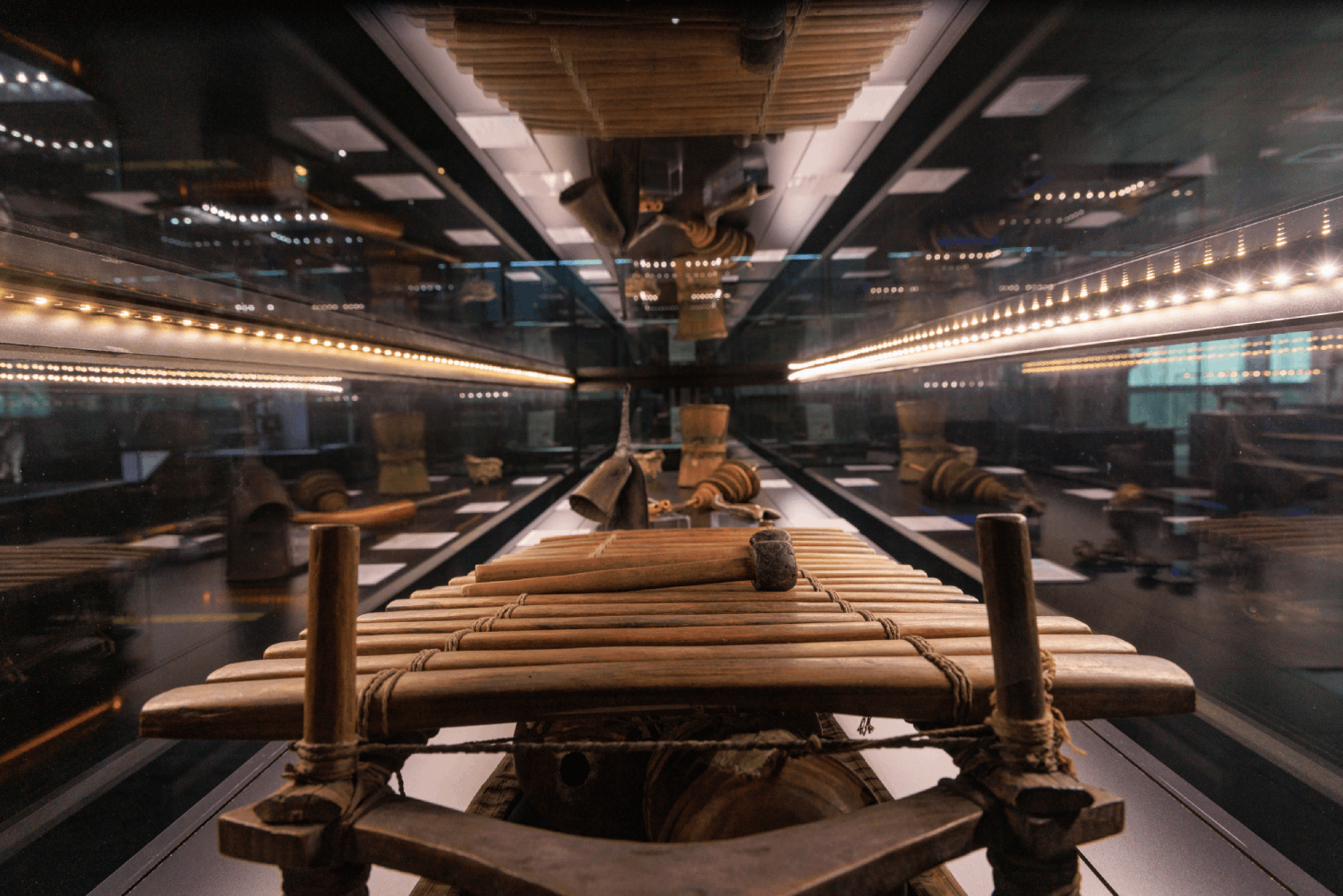
Major functions of life
Let your curiosity guide you between the specimens and objects that characterise the useful functions of living things.
To ensure their survival, humans have deployed strategies sometimes inspired by nature.
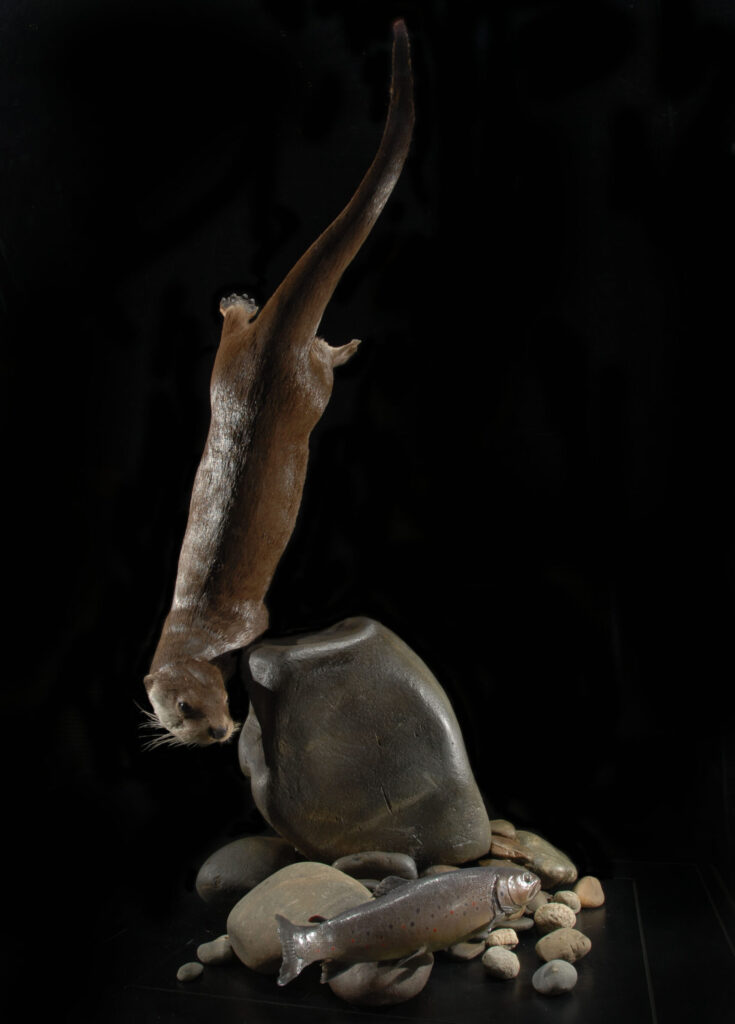
Feeding
Tree roots draw water and nutrients from the soil to support their growth. Animals feed on plants and hunt other animals. Humans cultivate, fish, gather… each species adapts to its environment to find the food it needs.
Otters are piscivorous: they feed mainly on fish. There are very good at fishing.
Protecting
Peau, cuticule végétale, coquille, carapace… chaque espèce développe des protections naturelles pour préserver ses organes vitaux ou résister aux variations de son environnement et du climat. Certains créent d’ingénieux systèmes tels que les épines ou les vêtements humains. Ou encore des camouflages imparables, à l’image du phasme qui se confond avec sa branche.
The armour of the Kiribati Indians in the Pacific is made from coconut fibre bristling with sharks’ teeth. The addition of symbolic materials, such as hair, provides magical protection.
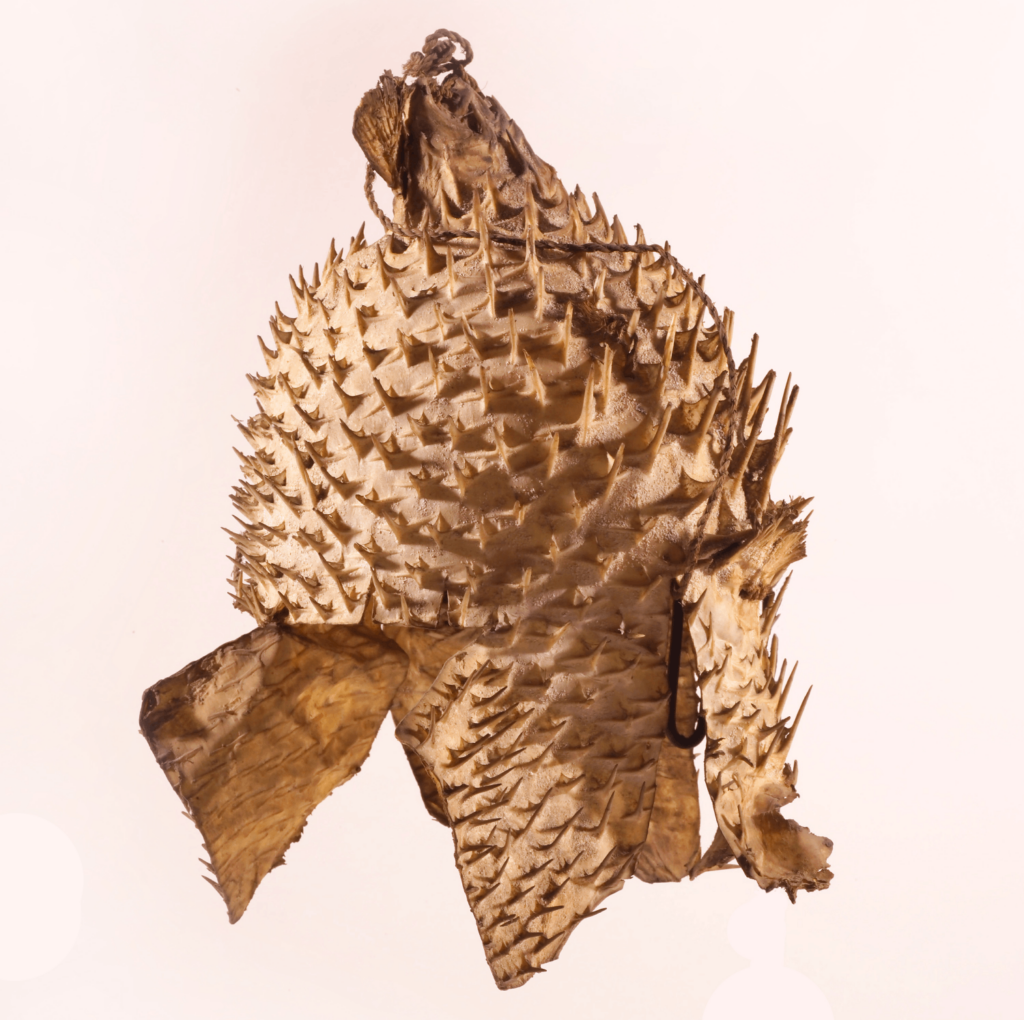
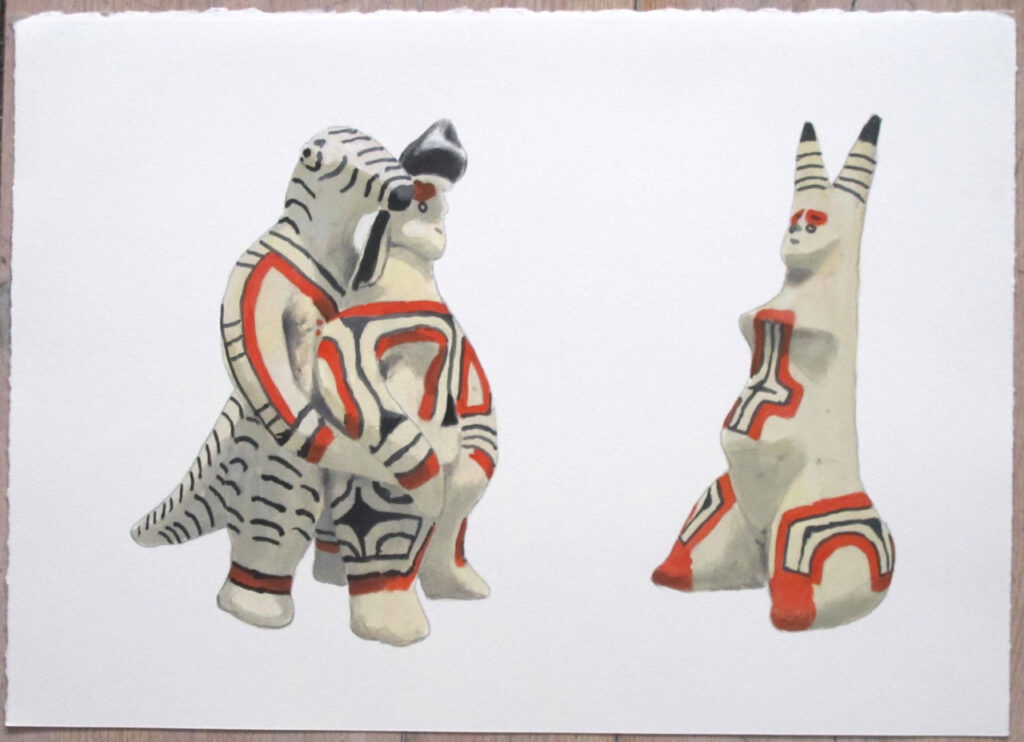
Breeding
Whether in plants, animals or humans, reproduction is essential to the survival of species. It also defines who we are in the living world. Reproduction can be ritualised to ensure we have the right partner or to emphasise its primary function.
The rituals of the Karaja Indians, embodied in these headdresses, pectorals and jewellery, are a reminder of the importance of reproduction, the basis of all life. These are figurines from this tribe in Brazil.
Travelling
Move according to your abilities, flee a predator, find food… each person has their own method adapted to their morphology and environment.
Skin clothing, wooden snowshoes, boots… to get around in the extreme cold, the Inuit have invented special equipment.
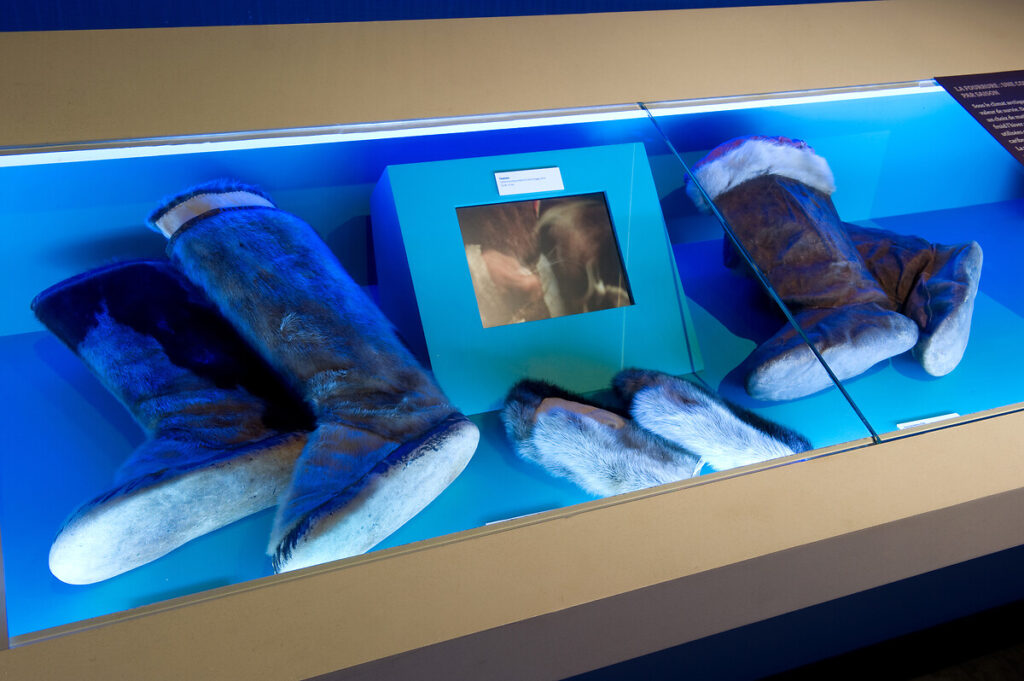
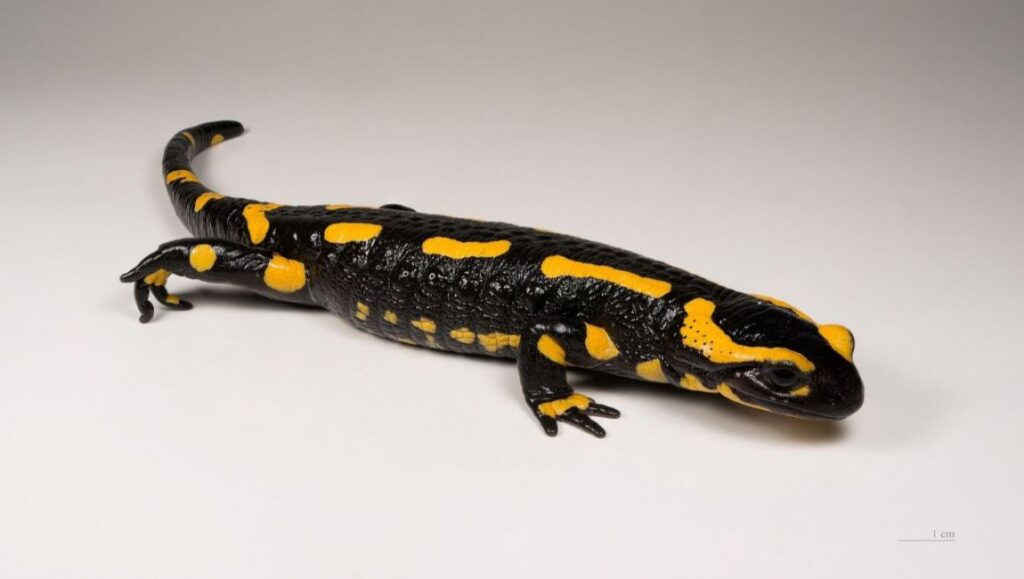
Perceiving and communicating
Humans know how to communicate in a variety of ways: through gestures, words, looks… Animals express themselves through waves, dances, cries or… colours! Plants also communicate, with each other and with their environment. Flowers tell pollinating insects whether they contain pollen to collect.
The yellow of the salamander indicates that it is dangerous to approach it: it spits a burning venom.
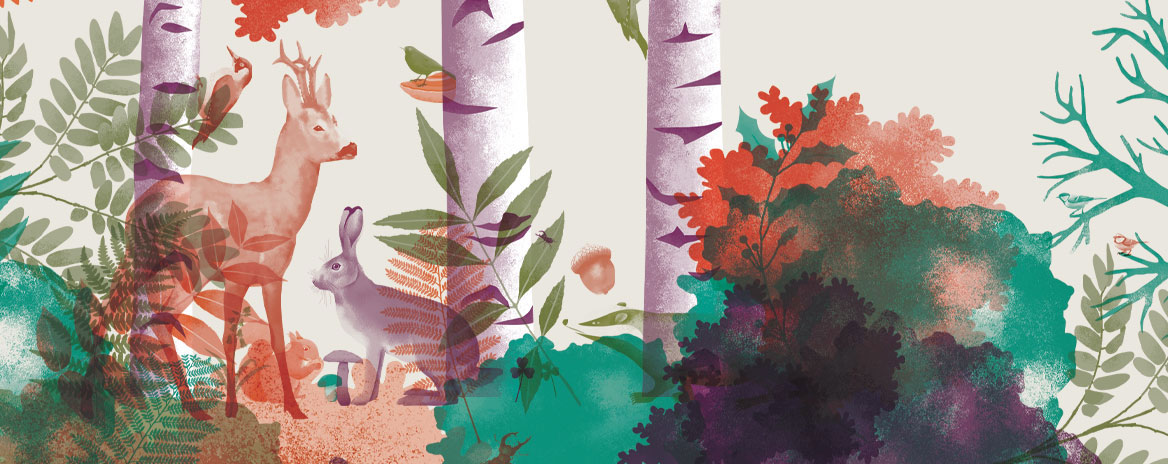
Biodiversity
A new 300 m² space devoted to biodiversity and the major issues involved in preserving it, to be discovered as part of the Museum’s permanent exhibition.
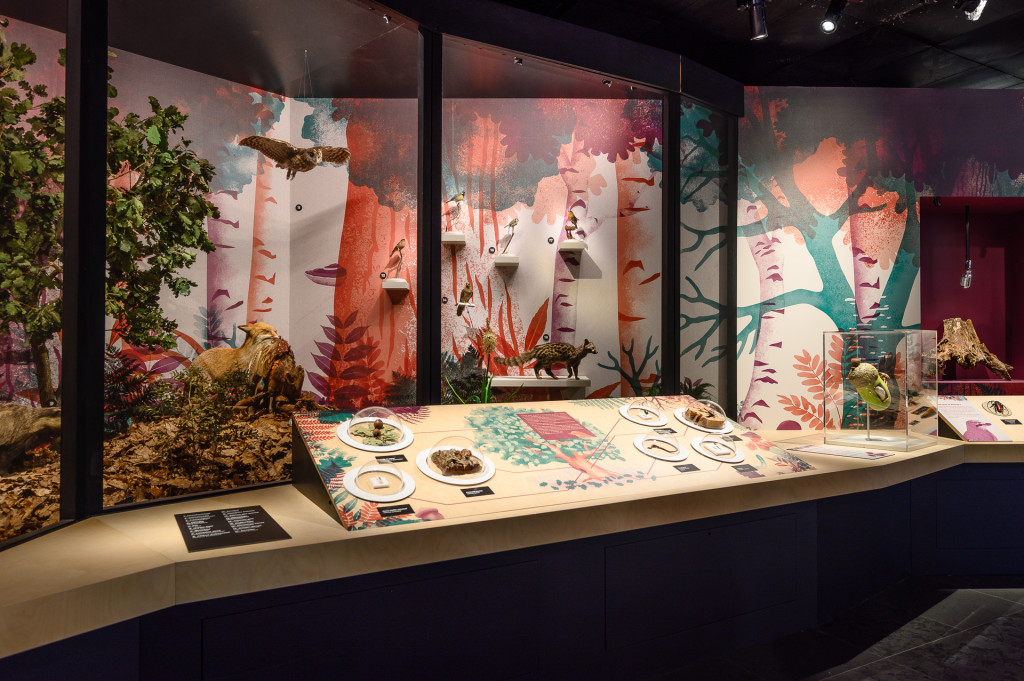
Content no avaible in english inside the exhibiton
On the 1st floor of its permanent exhibition, the Muséum has opened an area of almost 300 m² devoted to biodiversity and the major issues involved in preserving it.
You’ll wander through a teeming, colourful universe and come across a strange planet that is none other than our own bodies.
Take a virtual walk through the Bouconne forest to discover the magic of the soil, one of the most fascinating living constructions, home to a significant proportion of the Earth’s total biodiversity.
Then, move on to the scale of the planet, and realise that our health is directly dependent on the animals and plants that surround us, and the ecosystems we live in. Without biodiversity, the planet would be unliveable, neither for the human race and for a large part of the living world. If nothing is done to halt the decline in biodiversity, our planet will become almost uninhabitable for humans.
Header photo credit: Patrice Nin, Muséum de Toulouse

